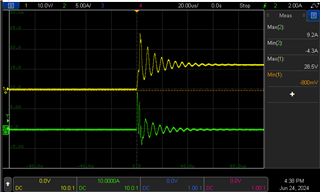Tool/software:
Hi expert,
Customer used TPS259460 with application 12V(typ.) and 5.3A continuous maximum.
Here is a test waveform during adapter plug-in. Some questions:
1. they have TVS at input, why the input voltage still go up to 28.5V over the absolute rating?
2. they set current limit at about 5.9A but why we still see current go to 9.2A? Is there an absolute maximum current rating for the TPS259460? Cause I see the DS spec internally limited.

Schematic: TPS259460ARPW_circuit.pdf
Thanks,
Allan







